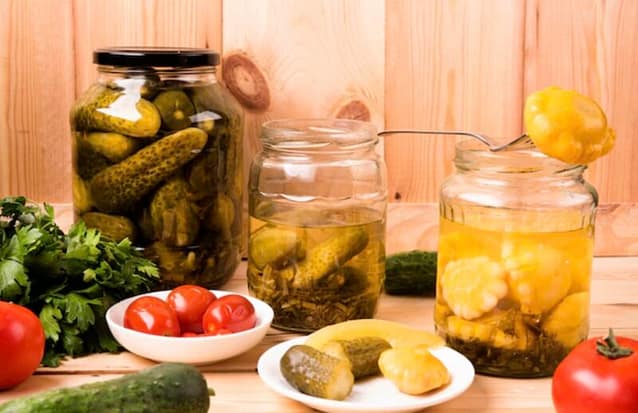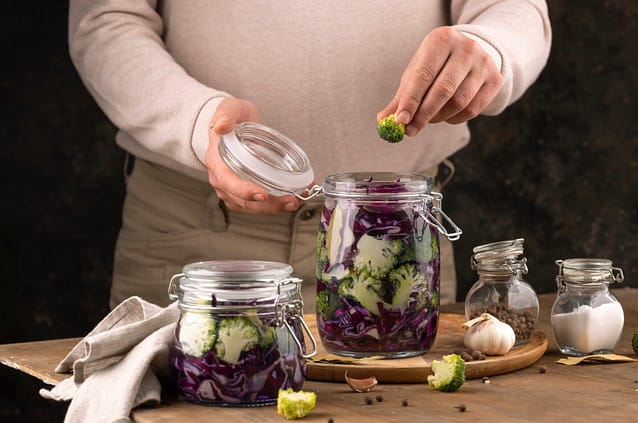Natural fermentation as a food preservation method is highly effective. By harnessing the power of beneficial bacteria and yeast, it not only extends shelf life but also enhances flavors and promotes probiotic benefits. With proper techniques and monitoring, you can safely preserve a wide range of foods using natural fermentation.
I. Introduction
Preserving the bountiful goodness of food has been a timeless endeavor, and natural fermentation emerges as a remarkable solution. Beyond mere preservation, this ancient method harnesses the power of beneficial microorganisms to unlock a world of flavor, nutrition, and probiotic benefits.
Dive into natural fermentation as a food preservation method, where tradition meets innovation and culinary delights await. Embark on a journey to preserve nature's treasures while enriching your palate and nourishing your body.
II. The Science Behind Natural Fermentation
Natural fermentation is a captivating biological process that has been harnessed by humans for centuries. At its core, fermentation is a metabolic conversion driven by microorganisms such as bacteria and yeast.
These tiny agents transform the sugars present in food into various compounds, including alcohol, acids, and gases, resulting in unique flavors, textures, and preservation. Lactic acid bacteria, for instance, convert sugars into lactic acid, contributing to the tangy taste and characteristic preservation of fermented foods.
Yeast, on the other hand, produces alcohol and carbon dioxide, playing a vital role in the fermentation of beverages like wine and beer. By understanding the science behind natural fermentation, we can appreciate the intricate interplay between microorganisms and our culinary creations, unlocking a world of delicious possibilities.
III. Benefits of Natural Fermentation as a Food Preservation Method
Natural fermentation offers a plethora of benefits as a food preservation method, making it a compelling choice for culinary enthusiasts and health-conscious individuals alike. Here are some key advantages:
A. Preservation without artificial additives or preservatives
Natural fermentation relies on the activity of beneficial microorganisms, eliminating the need for synthetic preservatives, additives, or chemical interventions.
B. Retention of nutrients and enhanced digestibility
The fermentation process enhances the bioavailability of nutrients, making them easier for our bodies to absorb. It can break down complex compounds, such as phytic acid in grains, improving digestion and nutrient absorption.
C. Development of unique flavors and textures
Fermentation introduces a complex array of flavors, aromas, and textures to food, transforming ordinary ingredients into extraordinary culinary experiences. From the tangy notes of sauerkraut to the effervescence of kombucha, fermented foods offer a sensory delight.
D. Probiotic benefits and improved gut health
Fermented foods are teeming with beneficial bacteria, known as probiotics, which can positively influence our gut microbiota. Probiotics support a healthy digestive system, strengthen the immune system, and may even contribute to overall well-being.
E. Extended shelf life
Through the natural fermentation process, the growth of harmful bacteria and spoilage organisms is inhibited, extending the shelf life of food items. Fermented foods can often be stored for longer periods without losing their quality or safety.
By embracing natural fermentation, we can savor the rich flavors, enhance nutrition, and promote a healthier gut, all while appreciating the artistry of preserving food through time-honored methods.
IV. Common Foods and Ingredients Suitable for Natural Fermentation
Numerous foods and ingredients lend themselves beautifully to natural fermentation, allowing for a diverse range of flavors and culinary experiences. Here are some common examples:
A. Vegetables
Cabbage (for sauerkraut), cucumbers (for pickles), carrots, radishes, beets, onions, garlic, and more. These vegetables can be transformed into tangy, probiotic-rich delights through fermentation.
B. Dairy Products
Milk can be fermented to create yogurt, kefir, sour cream, and buttermilk. Each offers its unique taste and texture while providing beneficial bacteria for gut health.
C. Grains and Legumes
Grains like rice and wheat, as well as legumes (know more about it in my blog post) such as soybeans, can undergo fermentation processes. Sourdough bread, for example, relies on a fermented starter culture to develop its distinctive tang and texture.
D. Fruits
While less commonly fermented than vegetables, certain fruits can be used to create delicious fermented beverages. Examples include grapes (for wine), apples (for cider), and plums (for umeboshi).
E. Tea and Herbs
Tea leaves, such as Camellia sinensis for kombucha, and herbal infusions can be fermented to produce flavorful and healthful beverages.
F. Soy Products
Soybeans are a versatile ingredient for fermentation. They can be transformed into miso, tempeh, soy sauce, and natto, each offering distinct flavors and textures.
G. Beverages
In addition to tea-based ferments like kombucha, other fermented beverages include kefir (fermented milk), kvass (fermented grain or vegetable drink), and mead (fermented honey).
These examples represent just a fraction of the wide variety of foods and ingredients that can undergo natural fermentation. Let your culinary creativity flourish as you explore the possibilities and embark on a journey of flavor and fermentation.
To know more about what you need, read my blog post about fermentation ingredients.

V. Techniques and Tips for Successful Natural Fermentation
To ensure successful natural fermentation, follow these techniques and tips:
A. Quality Ingredients
Start with fresh, high-quality ingredients. The quality of your ingredients will directly impact the flavor and outcome of fermentation.
B. Sanitize Equipment
Thoroughly clean and sanitize all utensils, containers, and tools to create a favorable environment for beneficial microorganisms and prevent the growth of harmful bacteria.
C. Salt or Starter Culture
Use salt or a starter culture to initiate fermentation. Salt helps to control the growth of unwanted bacteria and promotes the growth of beneficial bacteria. A starter culture provides specific strains of microorganisms to kickstart the fermentation process.
D. Temperature and Environment
Maintain the optimal temperature range for fermentation. Different foods and ferments require different temperature ranges, so follow specific recipes or guidelines. Ensure the fermentation environment is clean and free from contaminants.
E. Time and Patience
Fermentation is a time-dependent process. Allow enough time for the fermentation to take place. The duration can vary depending on the food and desired flavor profile. Patience is key, as rushing the process may result in subpar or incomplete fermentation.
F. Monitoring and Adjustments
Regularly monitor the fermentation process. Look for signs such as bubbling, release of gases, or changes in aroma and taste. Adjust factors like temperature or salt content if necessary to optimize the fermentation conditions.
G. Proper Storage
Once fermentation is complete, transfer the fermented food to appropriate containers. Use airtight jars or vessels to prevent contamination and store them in a cool place, such as a refrigerator or cellar, to slow down further fermentation.
H. Learn from Experience
Embrace experimentation and learn from your fermentation experiences. Each batch may differ slightly, and adjusting factors like salt content, time, or ingredients can lead to personalized and perfect results.
By following these techniques and tips, you can increase your chances of successful fermentation, enjoy delicious flavors, and create nutritious, probiotic-rich foods.
VI. Traditional Fermentation Practices from Around the World
Traditional fermentation practices from around the world showcase the rich cultural diversity and culinary heritage of different regions. Here are a few notable examples:
A. Kimchi (Korea)
Kimchi is a staple in Korean cuisine, made by fermenting vegetables like cabbage, radishes, and scallions with a mixture of seasonings, including chili pepper, garlic, and ginger. It is renowned for its complex flavors and health benefits.
B. Sauerkraut (Germany)
Sauerkraut is a fermented cabbage dish commonly associated with German cuisine. Shredded cabbage is fermented with salt, resulting in a tangy and crunchy condiment that pairs well with various dishes.
C. Tempeh (Indonesia)
Tempeh is a traditional Indonesian food made by fermenting soybeans. The beans are cooked, inoculated with a specific mold, and left to ferment. The result is a protein-rich, nutty-flavored product that is widely used as a meat substitute.
D. Sourdough Bread (Various Cultures)
Sourdough bread is made using a fermented starter culture of wild yeast and lactobacilli. It has been a staple in many cultures, including San Francisco sourdough and the traditional French levain, each contributing its unique flavor and characteristics.
E. Miso (Japan)
Miso is a traditional Japanese seasoning made from fermented soybeans, salt, and koji (a type of fungus). The mixture is aged for months or even years, resulting in a savory and umami-rich paste used in soups, marinades, and dressings.
F. Kefir (Caucasus Region)
Kefir is a fermented dairy beverage that originated in the Caucasus region. It is made by inoculating milk with kefir grains, which consist of a mixture of bacteria and yeast. The fermentation process produces a tangy, effervescent drink packed with probiotics.
G. Kvass (Eastern Europe)
Kvass is a fermented beverage commonly consumed in Eastern European countries. It is typically made from rye bread or other grains, fermented with water, sugar, and sometimes fruits or herbs, resulting in a slightly sour and mildly alcoholic drink.
H. Shrimp Paste (Bagoong)(Philippines)
Shrimp Paste is a traditional condiment made from fermented fish or shrimp, often mixed with salt and other ingredients. It has a strong, savory flavor and is commonly used in Filipino dishes such as Kare-Kare and Binagoongan.
Exploring these traditional fermentation practices allows us to appreciate the rich cultural heritage and diverse flavors that emerge from different corners of the world. It highlights the artistry and wisdom passed down through generations, offering a fascinating glimpse into the global tapestry of fermented foods.
VII. Integrating Natural Fermented Foods into Your Diet
Integrating naturally fermented foods into your diet is a delightful way to enhance flavor and nutrition. Here are some tips for incorporating these culinary delights into your daily meals:
A. Start Small
If you're new to fermented foods, begin by introducing them in small amounts. Start with a teaspoon of sauerkraut or a dollop of yogurt and gradually increase your intake as your taste buds adjust.
B. Pairing Possibilities
Experiment with pairing fermented foods with different dishes. Add a spoonful of kimchi to your stir-fries or tacos, top your salads with a sprinkle of sauerkraut, or enjoy yogurt with fresh fruits for a nourishing snack.
C. Creative Condiments
Use fermented condiments (read my blog post about it) to add depth and complexity to your meals. Try using miso as a flavor enhancer in soups, dressings, and marinades, or drizzle some kefir over roasted vegetables for a tangy twist.
D. Beverage Bliss
Incorporate fermented beverages into your routine. Enjoy a glass of kombucha as a refreshing alternative to soda, or sip on kefir for a probiotic-rich beverage option. Explore the world of fermented teas like pu-erh or herbal infusions for added variety.
E. Homemade Creations
Consider making your fermented foods at home. Experiment with DIY sauerkraut, pickles, or kombucha brewing. It allows you to customize flavors and ensure the use of quality ingredients.
F. Balanced Variety
Remember to maintain a balanced diet by incorporating fermented foods alongside other nutrient-dense foods. They can complement a range of dietary preferences, from plant-based to omnivorous, enhancing both taste and nutritional profile.
G. Recipe Exploration
Explore recipes that incorporate fermented ingredients as key elements. Discover the versatility of tempeh in stir-fries or experiment with sourdough bread for sandwiches and toasts. The possibilities are endless!
By embracing the integration of naturally fermented foods, you can elevate your culinary experiences, nurture your gut health with beneficial probiotics, and enjoy a wide array of flavors that add depth and character to your meals. Let your taste buds guide you on a journey of delicious discovery!

VIII. Addressing Concerns and FAQs about Natural Fermentation
Addressing concerns and frequently asked questions (FAQs) about natural fermentation helps to provide clarity and alleviate any uncertainties. Here are some common concerns and their answers:
Is natural fermentation safe?
Yes, when done correctly, natural fermentation is a safe method of food preservation. The acidic environment created by fermentation inhibits the growth of harmful bacteria. However, it's essential to follow proper hygiene practices. Use quality ingredients, and monitor the fermentation process to ensure safety.
How can I tell if my fermented food is spoiled?
Trust your senses. If your fermented food has an off-putting odor, unusual texture, or an unpleasant taste, it may be a sign of spoilage. Mold growth or excessive gas production are also indicators of potential spoilage. When in doubt, it's best to discard the food.
Can I ferment food without salt?
While salt is commonly used in fermentation to control microbial growth and enhance flavors, it is possible to ferment without it. However, omitting salt increases the risk of spoilage, so extra care must be taken to maintain a clean and controlled fermentation environment.
How long does fermentation take?
The duration of fermentation varies depending on factors such as the type of food, temperature, and desired flavor. Fermentation can take anywhere from a few days to several weeks or even months. Regular monitoring and tasting will help determine when the desired flavor and texture have been achieved.
Can I ferment foods without specialized equipment?
Yes, you can ferment foods without specialized equipment. Basic kitchen tools like glass jars, airtight containers, or fermentation weights can suffice. However, investing in fermentation-specific equipment, such as fermentation crocks or airlocks, can offer more precise control and ease of use.
Are fermented foods suitable for everyone?
Fermented foods are generally safe and beneficial for most people. However, individuals with certain health conditions or compromised immune systems should consult their healthcare provider before consuming large amounts of fermented foods. Additionally, those with specific dietary restrictions or allergies should ensure that fermented foods align with their dietary needs.
Do fermented foods lose their nutritional value?
While fermentation can alter the nutritional composition of foods, it often enhances their digestibility and bioavailability of certain nutrients. Fermented foods can be rich in probiotics, vitamins, minerals, and enzymes. However, heat processing or prolonged storage can affect the probiotic content, so consuming them fresh or homemade is ideal.
Addressing these concerns and FAQs promotes understanding and confidence in incorporating natural fermentation into one's lifestyle. Remember to adapt techniques and practices to suit personal preferences and consult experts or reliable resources for specific inquiries.
IX. Additional References
- Effect of Fermentation on the Nutritional Quality of the Selected Vegetables and Legumes and Their Health Effects (2023) https://www.ncbi.nlm.nih.gov/pmc/articles/PMC10051273/
- Effect of fermentation of chosen vegetables on the nutrient, mineral, and biocomponent profile in human and animal nutrition (2022) https://www.ncbi.nlm.nih.gov/pmc/articles/PMC9352655/
- Traditional Fermented Foods and Beverages from around the World and Their Health Benefits (2022) https://www.ncbi.nlm.nih.gov/pmc/articles/PMC9227559/
X. Conclusion
Fermentation as a Food Preservation Method is a captivating and time-honored method that offers a lot of benefits. It allows us to unlock unique flavors, improve nutritional value, and promote gut health through the power of beneficial microorganisms. By embracing fermented foods, we can expand our culinary horizons, creating a diverse and exciting array of flavors in our everyday meals.
While venturing into the world of fermentation may seem intimidating, following proper techniques, experimenting with different recipes, and learning from experience can make it an enjoyable and rewarding journey. Whether you're savoring the tangy crunch of sauerkraut, indulging in the rich flavors of miso, or delighting in the sparkle of kombucha, fermented foods offer a gateway to a world of taste sensations and holistic well-being.
So, why not embrace the art of natural fermentation and explore the countless possibilities it presents? Let your taste buds guide you as you integrate these probiotic-rich foods into your diet, creating a symphony of flavors and nourishment.
Experience the joy of creating your fermented creations or savoring traditional fermented delicacies. As you embark on this culinary adventure, may your plates be filled with the goodness of natural fermentation, connecting you to tradition, health, and the vibrant tapestry of global gastronomy.
XI. My Experience
In my culinary journey, I've discovered the art of preserving nature's bounty through the ancient method of natural fermentation. This time-honored technique has become my go-to for safeguarding the vibrant flavors of seasonal fruits and vegetables, especially my favorites. From the crisp freshness of summer apples to the earthy richness of fall pumpkins, the magic of fermentation not only preserves but enhances the essence of each ingredient.
I have a blog post about the environmental benefits of fermentation, read all about it and it may encourage you more to do your fermentation.
Join me in how I've harnessed the power of fermentation to extend the life of my beloved seasonal produce, ensuring a year-round celebration of nature's delicious offerings.
 Discover More About the World of Natural, Vegan, and Organic Goodness!
Discover More About the World of Natural, Vegan, and Organic Goodness!
Explore my other blog posts to uncover the secrets of a healthier lifestyle through natural and sustainable choices. I'd love to hear about your experiences and insights! Share your journey with me and let's create a community of wellness enthusiasts together.

 Discover More About the World of Natural, Vegan, and Organic Goodness!
Discover More About the World of Natural, Vegan, and Organic Goodness!

 Simple. Natural. Better.
Simple. Natural. Better.